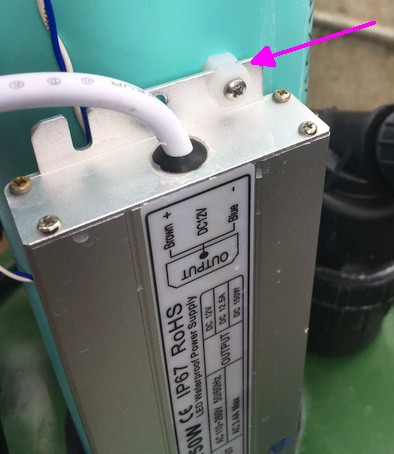I finally figured out the cause of the noisy pH measurements. The nutrient solution was being affected by an intermittent very high resistance connection to ground. Breaking the connection to ground fixed the problem.
The picture below shows the original noisy pH measurements on the left, pH measurements mostly saturated at the ~pH 2 circuit minimum in the middle after changing to a new pH probe, and the now valid non-noisy pH measurements on the right. In the middle, the actual pH was above 7, but it saturated to around pH 2 due to the unintentional ground connection.

So how did a high resistance connection to ground cause these faulty readings? To understand this, you need to understand that a pH probe is basically a battery in series with a VERY large resistance. The voltage on the battery changes with the pH. The probe voltage drives an amplifier input that draws so little current that the large probe resistance doesn't affect the voltage measurement that much. The pH probe is in electrical contact with the solution, so if you ground the solution, the pH probe reading gets shifted.
So, where was the connection to ground coming from? From the screws that hold the power supply to the support pipe indicated in the photo below. The screws at the top and bottom of the supply go all the way through the pipe wall. The connection was from the grounded case on the power supply, through the screws, down the wall on the interior of the pipe, through the nutrient solution, and finally to the pH probe.

The tricky part is that the connection inside the pipe depends on the conductivity between the screws and the surface of the water. This depends on how wet the inside wall of the pipe is. The pipe wetness depends on how it gets splashed from water coming from above. Because splashing is pretty random, the conductivity is pretty random. The measurement system is designed with pH 7 at 2.5V and ground is 0V, so connecting the nutrient solution to ground makes the measured pH artificially lower than it really is.
In order to fix the problem, I isolated the screws holding on the power supply using nylon nuts and heat shrink tubing as shown below. After this modification, the pH noise is gone. The changes on the right hand side of the graph are caused by actually adding pH down solution, not by intermittent ground connections. The takeaway is, when making very high resistance measurements, always make sure that there are no stray lower resistance connections.

 Chris Johnson
Chris Johnson
Discussions
Become a Hackaday.io Member
Create an account to leave a comment. Already have an account? Log In.